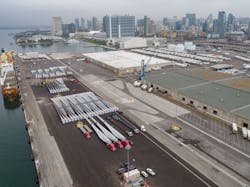EDF Renewables to Install “Crown Jewel” of San Diego Port’s Climate Plan: A Microgrid
The Port of San Diego, one of a growing number of large infrastructure projects incorporating microgrids, has taken the next big step in its climate plan by awarding a $2.7 million microgrid installation contract to EDF Renewables Distribution Systems.
“We are excited. We’re in a race to be the first microgrid at a port in the US,” said Marshall Merrifield, a Port of San Diego Board of Port commissioner. “The microgrid is going to be the crown jewel in our efforts to achieve the goals in our climate action plan,” he said, noting that the port was the first to create such a plan. “It should be a model for any cargo terminal in the country.”
The contract was awarded by the board as part of a $9.6 million effort, $4.9 million of which was funded by a grant from the California Energy Commission’s (CEC) Electric Program Investment Charge (EPIC) Program. The CEC grant pays for the $2.77 million cost of the microgrid infrastructure construction design and consulting support, said a spokeswoman for the Port of San Diego.
The microgrid is expected to be complete by the end of 2021.
Strategic to military
The facility is a strategic port that provides services to the US military, which can take over the terminal within 48 hours’ notice to respond to natural or man-made emergencies.
“That means we want power operating our infrastructure and terminal morning, noon and night regardless of any power outage or wildfire,” said Merrifield.
The microgrid will provide backup power to specific port facilities, and includes solar that will be located on a warehouse and 2,400 kWh of battery storage that will run for four hours.
A contract for the solar portion of the project has not yet been awarded. EDF will provide the storage.
The project is part of the recently completed Tenth Avenue Marine Terminal Redevelopment Project, and aims to help create a clean and more efficient cargo terminal.
The microgrid will serve an underground electrical distribution loop that feeds lighting needed for security and gate cameras. Also underground is a jet fuel storage facility, run by a contractor, that uses electricity to pump jet fuel to the airport.
The microgrid will yield $3.2 million in energy savings — more than the project’s $2.77 million construction cost.
Funds for the larger $9.6 million project come from the port, with a $4.2 million investment, and the University of California San Diego (UCSD), with a $201,000 investment. UCSD will focus on testing, data gathering and how to respond to grid pricing and other issues.
A recent study concluded the microgrid will yield $3.2 million in energy savings to the port over 20 years, which is more than the project’s $2.77 million construction cost, said the Port spokeswoman.
Five bidders bid on the microgrid contract, with bids ranging from $2.7 million to about $4 million, said Merrifield.
Over the summer, when California experienced wildfires, the Port of San Diego was asked by utility San Diego Gas & Electric (SDGE) to prepare for rolling blackouts and public safety power shutoffs (PSPS), he said. But ultimately, it experienced no blackouts or PSPS.
Traumatic and dramatic summer
“Throughout California this past season, it was traumatic and dramatic,” said Merrifield.
For such emergencies, the microgrid, through its controller, can receive notifications from the utility. They might include time of use costs, or information about outages or brownouts.
“The microgrid controller can respond to those emergencies,” he said.
In addition to saving money and providing resilience to the port and airport, the microgrid will provide resilience in a neighboring community categorized by the CEC as an environmental justice community.
The terminal is also located in the middle of a high-density urban center that’s home to many industrial companies.
Climate plan includes electrification
In a companion project, the port also is advancing into vehicle electrification. The Port Tenants Association in 2016 received $5.9 million from the CEC to electrify electric heavy duty equipment that includes electric drainage trucks, yard tractors and forklifts.
“The tenants using those products have been impressed with their capability. They are all quiet. That has stimulated a lot of private tenants to ask how do we do more of this,” said Merrifield.
The CEC microgrid grant is part of the CEC’s Business Case Demonstration for Advanced Microgrids program, which aims to move forward California’s energy and greenhouse gas policies. It focuses on improving air quality and cutting greenhouse gas emissions through electrification, demonstrating a reliable and resilient system, providing technological advancement to achieve the state’s energy goals, and developing a model that can be used elsewhere.
”…growing the industrial economy while reducing our carbon footprint” — Merrifield
“If there’s a message from the port, it would be this: “It’s possible to continue growing the industrial economy while reducing our carbon footprint,” said Merrifield.
Port resilient in its resilience
The project is moving forward in spite of the COVID-19 crisis, said Renee Yarmy, Port of San Diego’s program manager of energy and sustainability.
“We are ahead of a lot of the other ports in exploring microgrids,” she said. “In spite of COVID and all the other hiccups, we have been resilient in our resilience.”
In addition, to the Port of San Diego, several other infrastructure projects are in various stages of incorporating microgrids, among them Pittsburgh International Airport, John F. Kennedy International Airport, London City Airport, Chattanooga Airport, Redwood Coast Airport and Port of Long Beach, Port of Los Angeles.
Track news about the Port of San Diego microgrid project. Subscribe to the free Microgrid Knowledge newsletter.








